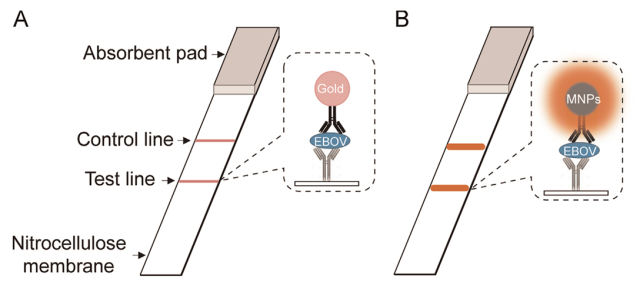Release date: 2015-10-14

The Ebola outbreak in West Africa in 2014 shocked the world. In the absence of effective treatment at the time, people quickly realized the importance of early detection and isolation of patients to control the epidemic. Although technologies such as RT-PCR and ELISA have played an important role, these technologies are difficult to be rapidly popularized due to local environmental constraints. In view of this, "Nature" even specifically called on scientists to develop new detection techniques that are simple, fast and economical.
Based on the work of nano-enzymes (Nature Nanotechnology 2007, 2012), the research group of the Institute of Biophysics of the Chinese Academy of Sciences developed a new technology for “nano-enzyme test stripsâ€. This technology replaces the colloidal gold in the traditional test strip with magnetic nano-enzyme, which improves the sensitivity of the test strip by 100 times. The mechanism of this signal amplification comes from two aspects: First, the nano-enzyme probe molecule has magnetic properties. The sample can be separated and enriched; secondly, the nano-enzyme has catalytic activity, can make the substrate color, and improve the detection sensitivity. This new technology not only provides a simple means for rapid detection of Ebola and other viruses, but also can be applied to field investigations such as early diagnosis of tumors and inspection and quarantine of customs ports at customs by switching the types of antibodies on the probes.
In cooperation with the Chinese Center for Disease Control and Prevention, Dr. Gao Fu, Liang Mifang, and the researcher of the Academy of Military Medical Sciences, Cao Wuchun, the research team of Yan Xiyun successfully applied the technology to the detection of Ebola, Newbuna, and influenza. This achievement has been published in the bioprobe journal Biosensors and Bioelectronics and was immediately named as Top 25 Hottest Articles; ELSEVIER also distributed a special comment, saying that the technology has overcome The traditional test strip method is expected to become a weapon for controlling Ebola transmission due to the bottleneck problem of low sensitivity and limited long-term application.
Source: Bio Valley
1. What is SARMS? Is SARMS a drug?
SARMS is a selectively targeted androgen receptor modulator.
By regulating the receptivity and availability of androgens to muscle cells, which correspond to Steroids. Steroids are exogenous androgens, while SARMS regulates the absorption and use of androgens in muscles. Both exogenous and endogenous androgens can be regulated. So the results of steroid +SARMS can be imagined!
SARMS is not strictly a drug; it is a substance that sits somewhere between a supplement and a drug.
2. What are the characteristics and advantages of SARMS?
SARMS, a selective androgen receptor modulator, is considered as a bridging compound in bodybuilding that produces similar results to steroids, but without the same side effects. All SARMS do not suppress viscera, have no hepatotoxicity, and do not transfer to females.
3. Introduction of SARMS common categories?
SARMS series of quality products :S4, YK-11, GW-501516, LGD-4033, MK2866, MK-677, RAD-140,LGD-3303, SR9009
Mk-2866: MK2866- Selectively performs anabolic activity on certain ARs, which is very helpful for maintaining and increasing lean meat quality and resilience.
Lgd-4033 - A powerful non-steroidal bodybuilding supplement used to enhance muscle mass and reduce body fat
Ostarine (MK-2866) - Selective anabolic activity, well suited for maintenance
99% Powder Agmatine Sulfate,Powder Agmatine Sulfate,Agmatine Sulfate Powder
Shaanxi YXchuang Biotechnology Co., Ltd , https://www.peptide-nootropic.com